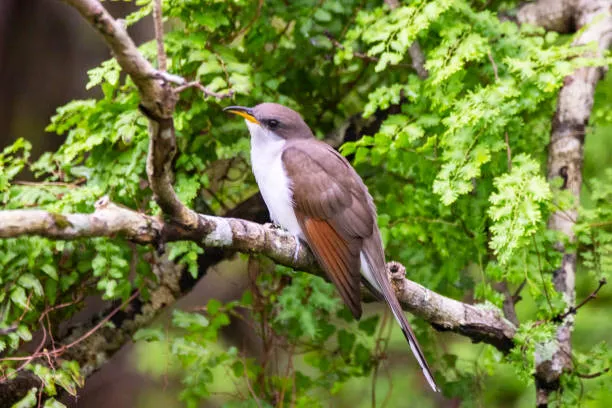The Yellow-Billed Cuckoo (Coccyzus americanus) is an intriguing bird species known for its distinctive appearance, migratory behavior, and remarkable vocalizations. In this article, we delve into the range of the Yellow-Billed Cuckoo, exploring the regions it inhabits throughout North and Central America. By understanding its distribution, we can gain insights into the bird’s ecological preferences and contribute to its conservation.
Geographic Distribution:
The Yellow-Billed Cuckoo’s range spans across North and Central America, encompassing diverse habitats within different countries. Here is an overview of its geographic distribution:
-
North America:
United States: The Yellow-Billed Cuckoo can be found throughout much of the United States, particularly in the eastern and central regions. Its range extends from the Atlantic coast westward to the Great Plains and as far north as parts of southern Canada. Key states where the cuckoo can be observed include Texas, Oklahoma, Kansas, Nebraska, the Dakotas, Montana, and parts of the Pacific Northwest.
Canada: In Canada, the Yellow-Billed Cuckoo’s range extends into southern regions, including southern Ontario and parts of Quebec.
-
Central America:
Mexico: The Yellow-Billed Cuckoo occupies various regions of Mexico, including the Baja California Peninsula, the Gulf Coast, and the Yucatan Peninsula. It can also be found in the Sierra Madre Oriental and Sierra Madre Occidental mountain ranges.
Central American Countries: The cuckoo’s range extends southward into Central America, encompassing countries such as Guatemala, Belize, Honduras, El Salvador, Nicaragua, Costa Rica, and Panama.
Habitat Preferences:
The Yellow-Billed Cuckoo demonstrates a strong association with specific habitat types within its range. Understanding its habitat preferences is key to comprehending its distribution. Here are the primary habitats in which the Yellow-Billed Cuckoo thrives:
Riparian Zones: The cuckoo shows a particular affinity for riparian habitats, including riverbanks, stream corridors, and wooded wetlands. These areas provide a rich source of food, such as caterpillars and insects, as well as suitable nesting sites within the dense vegetation along waterways.
Wooded Areas: The Yellow-Billed Cuckoo also occupies open woodlands, deciduous forests, and scrublands. It favors habitats with a mixture of trees and shrubs, as they offer ample foraging opportunities and suitable locations for nesting.
Migration:
The Yellow-Billed Cuckoo is known for its impressive migratory journeys, traveling between its breeding and wintering grounds. The bird’s migration pattern includes the following key aspects:
Breeding Season: During the breeding season, Yellow-Billed Cuckoos arrive in their northern breeding grounds across North America, including the United States and southern Canada. They typically arrive in April and May.
Wintering Grounds: In the winter months, the cuckoos undertake long-distance migrations to Central and South America. They can be found in countries such as Mexico, Costa Rica, Panama, Colombia, Venezuela, Ecuador, and even parts of northern South America.
Conservation Status:
The Yellow-Billed Cuckoo faces conservation challenges due to habitat loss, habitat fragmentation, and degradation of riparian zones. The reduction of suitable breeding and wintering grounds poses significant threats to the species. Efforts are underway to protect and restore riparian habitats, raise awareness about the bird’s ecological significance, and promote conservation measures to safeguard its range.
Conclusion:
The Yellow-Billed Cuckoo’s range spans across North and Central America, encompassing diverse habitats from the United States and Canada to Mexico and Central American countries. With a preference for riparian zones and wooded areas, the cuckoo’s distribution reflects its reliance on specific habitats for nesting, foraging, and breeding. Understanding the range and habitat preferences of the Yellow-Billed Cuckoo provides valuable insights for conservation efforts aimed at preserving its populations and ensuring its continued presence in the natural ecosystems it inhabits.
Related topics:
- What is a Yellow-billed Cuckoo?
- What does a Yellow-billed Cuckoo sound like?
- What does a Yellow-billed Cuckoo eat?


 Facebook
Facebook  Instagram
Instagram  Youtube
Youtube 